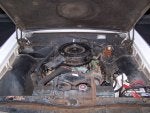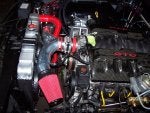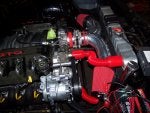I've got all the receipts so I could add it up, but I may not want to know!

The one component that would be difficult to duplicate exactly would be the heads, because they are real 69 GTO round port Ram Air IV's. I bought them many years ago, back before all the aluminum heads came out, and I really wanted to use them because of the 'cool' factor. In terms of power though, a good set of aluminum Edelbrocks or even the D-ports would probably make more torque/power. I really had to jump through some hoops to get the compression down to 9.46:1 with these heads.
Here's a parts list:
Eagle cast crank (3" main, 4.250 stroke, "BBC" rod journal size) and Eagle h-beam forged steel rods, 6.800" length
KB/ICON IC-967 forged pistons, additional dish cut for a total dish volume of 22 cc's.
Comp Cams solid roller cam. 236/242 intake/exhaust duration at .050, .377/.381 lobe lift, 110 degree LSA, installed at 106 degrees intake centerline
Pontiac #722 heads, 72cc chambers, heat riser passages plugged with aluminum, mild port job (282 cfm intake flow / 166 cfm exhaust flow at .600 valve lift)
Scorpion 1.65:1 roller rockers
Comp Cams "Endurex" solid roller lifters, pushrods, titanium retainers, superlocks, and rocker stud girdle.
Comp Cams billet 9-way adjustable timing set (cam installed 4 degrees advanced as per Comp Cams specs)
Howards Cams double valve springs (1.9" installed height, 175# seat pressure, 440# pressure at .700 lift)
Melling high pressure oil pump, Milodon main stud kit and windage tray, Nitemare performance oil pump plate, cam plate, oil pump drive shaft, and rear main seal
Milodon high flow alumimum water pump
Proform HEI ignition
Factory cast iron intake, port matched to gaskets and heads, water crossover cut and separated from the intake.
Service replacement 455 SD Quadrajet
Doug Thorley D-567 headers
Cometic head gaskets, .075 compressed thickness
RobbMc mechanical fuel pump and mini starter
SFI-rated harmonic balancer and flex plate
Milodon 'kick out' oil pan
I also went to extra effort to retain the use of the factory valve covers even though I'm running roller rockers and a stud girdle. I'm using some tall spacers, painted engine color. My goal was to be able to tell the casual observer, "yeah, it's the 400 that came in the car - nothing special" and get away with it ----- until they hear it run.

They really aren't that noticeable unless you're really paying attention.
The additional piston dish and the thicker head gaskets were compromises I had to make in order to reach the compression ratio I needed for 93 octane. I also didn't 'zero deck' the block because I really needed that extra bit of clearance volume that the .011 deck height gave me. These changes definitely have a negative effect on piston/head "quench" and thus combustion efficiency and flame travel --- but I had to do it to make sure I don't have detonation problems. Even with that, the motor still seems to be happiest at 32 degrees total advance so maybe I didn't hurt combustion efficiency too bad.
Running 87 cc chambers and flat tops would almost assuredly make a better running engine than mine, because you'd have both good quench and reasonable compression.
As far as machine work, I had the block align honed to straighten the main bores, bored (with a torque plate) to plus .035 for the pistons, "just enough" cut off the decks and heads to make sure they were square and flat, and a good 3-angle valve job done on the heads. I installed oil-restrictors in the lifter bores myself. Since I'm running solids, I don't need much oil to the lifters so that oil is better used if redirected to the crank and rods.
I don't know the torque output below 3100, but Engine Analyzer, the program I used to help design the motor, estimates 409 lb.ft. at 2300 rpm, 452 lb. ft. at 2700 rpm. That's probably not far off.

Bear









